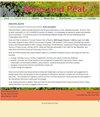Surface energy exchange in pristine and managed boreal peatlands
IF 1.5
4区 环境科学与生态学
Q4 ENVIRONMENTAL SCIENCES
引用次数: 8
Abstract
Surface–atmosphere energy exchange is strongly ecosystem-specific. At the same time, as the energy balance constitutes responses of an ecosystem to environmental stressors including precipitation, humidity and solar radiation, it results in feedbacks of potential importance for the regional climate. Northern peatlands represent a diverse class of ecosystems that cover nearly 6 × 106 km2 in the Boreal region, which makes the inter-comparison of their energy balances an important objective. With this in mind we studied energy exchange across a broad spectrum of peatlands from pristine fens and bogs to forested and agriculturally managed peatlands, which represent a large fraction of the landscape in Finland and Sweden. The effects of management activities on the energy balance were extensively examined from the micrometeorological point of view, using eddy covariance data from eight sites in these two countries (56o 12'–62o 11' N, 13o 03'–30o 05' E). It appears that the surface energy balance varies widely amongst the different peatland types. Generally, energy exchange features including the Bowen ratio, surface conductance, coupling to the atmosphere, responses to water table fluctuations and vapour pressure deficit could be associated directly with the peatland type. The relative constancy of the Bowen ratio in natural open mires contrasted with its variation in tree-covered and agricultural peatlands. We conclude that the impacts of management and the consequences of land-use change in peatlands for the local and regional climate might be substantial.原始和管理的北方泥炭地的地表能量交换
地表-大气能量交换具有强烈的生态系统特异性。同时,由于能量平衡构成了生态系统对包括降水、湿度和太阳辐射在内的环境压力源的反应,它导致了对区域气候具有潜在重要性的反馈。北方泥炭地代表了一类多样的生态系统,在北方地区覆盖了近6×106平方公里,这使得它们的能量平衡的相互比较成为一个重要目标。考虑到这一点,我们研究了从原始沼泽到森林和农业管理泥炭地的各种泥炭地的能量交换,这些泥炭地代表了芬兰和瑞典的大部分景观。利用这两个国家八个地点(北纬56o 12'-62o 11',东经13o 03'-30o 05')的涡度协方差数据,从微观气象学的角度广泛研究了管理活动对能量平衡的影响。不同泥炭地类型的地表能量平衡差异很大。通常,能量交换特征,包括Bowen比、表面电导、与大气的耦合、对地下水位波动的响应和蒸汽压不足,可能与泥炭地类型直接相关。自然开阔沼泽地的Bowen比率的相对恒定性与树木覆盖和农业泥炭地的变化形成了对比。我们得出的结论是,泥炭地的管理和土地利用变化对当地和区域气候的影响可能是巨大的。
本文章由计算机程序翻译,如有差异,请以英文原文为准。
求助全文
约1分钟内获得全文
求助全文
来源期刊

Mires and Peat
ENVIRONMENTAL SCIENCES-
CiteScore
2.30
自引率
16.70%
发文量
0
审稿时长
33 weeks
期刊介绍:
Mires and Peat is a peer-reviewed internet journal focusing specifically on mires, peatlands and peat. As a truly “free-to-users” publication (i.e. NO CHARGES to authors OR readers), it is immediately accessible to readers and potential authors worldwide. It is published jointly by the International Peatland Society (IPS) and the International Mire Conservation Group (IMCG).
Mires and Peat is indexed by Thomson Reuters Web of Science (2017 Impact Factors: 1.326 [two-year] and 1.638 [five-year]), Elsevier Scopus, EBSCO Environment Complete, CABI Abstracts, CSA Proquest (including their Aquatic Science and Fisheries Abstracts ASFA, Ecology, Entomology, Animal Behavior, Aqualine and Pollution databases) and Directory of Open Access Journals (DOAJ). Mires and Peat also participates in the CABI Full Text Repository, and subscribes to the Portico E-journal Preservation Service (LTPA).
Mires and Peat publishes high-quality research papers on all aspects of peatland science, technology and wise use, including:
ecology, hydrology, survey, inventory, classification, functions and values of mires and peatlands;
scientific, economic and human aspects of the management of peatlands for agriculture, forestry, nature conservation, environmental protection, peat extraction, industrial development and other purposes;
biological, physical and chemical characteristics of peat; and
climate change and peatlands.
Short communications and review articles on these and related topics will also be considered; and suggestions for special issues of the Journal based on the proceedings of conferences, seminars, symposia and workshops will be welcomed. The submission of material by authors and from countries whose work would otherwise be inaccessible to the international community is particularly encouraged.
 求助内容:
求助内容: 应助结果提醒方式:
应助结果提醒方式:


